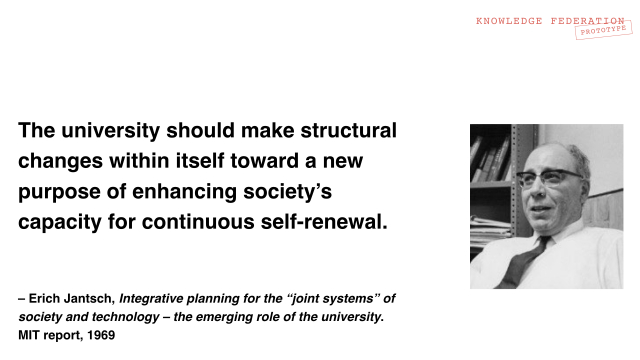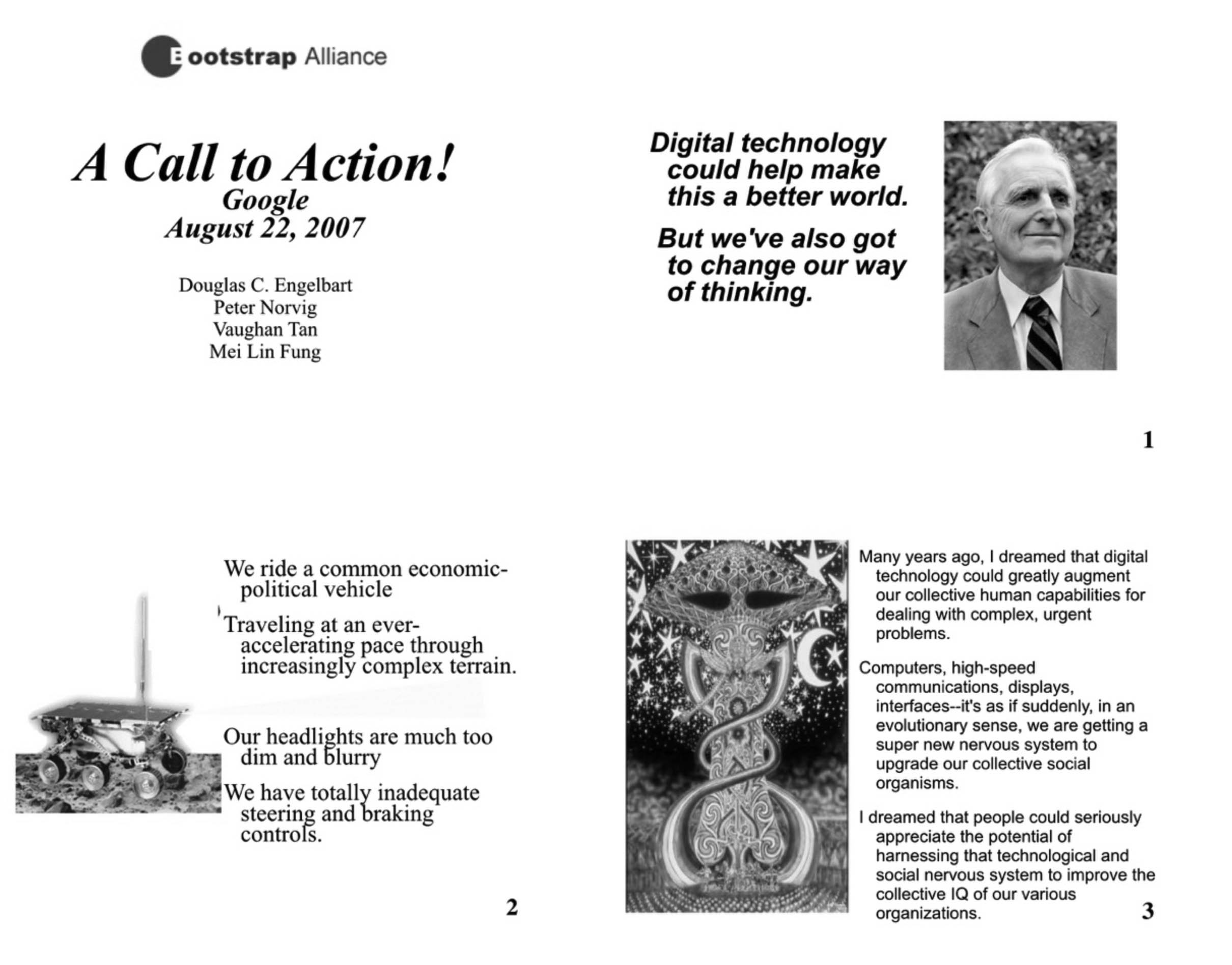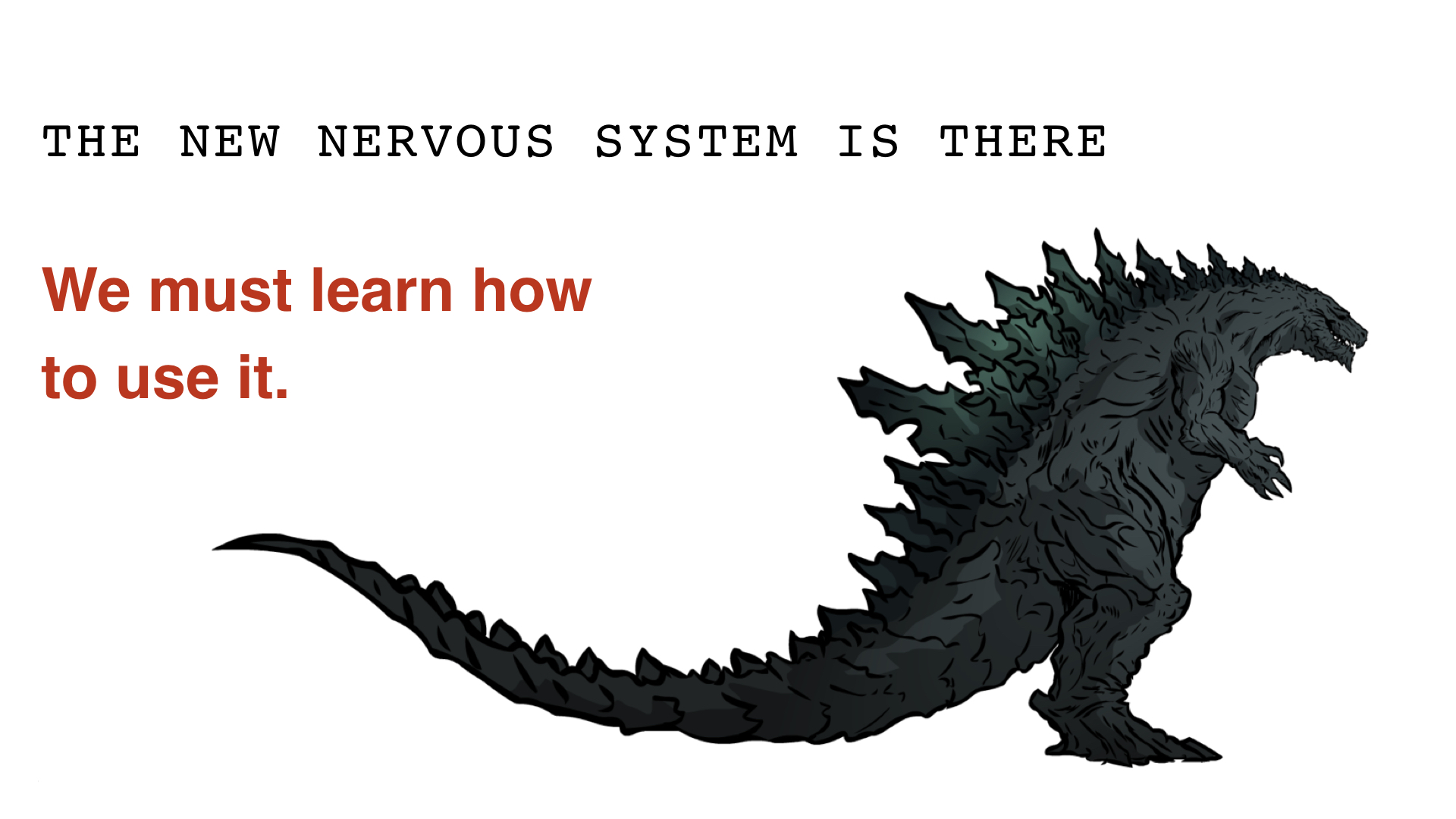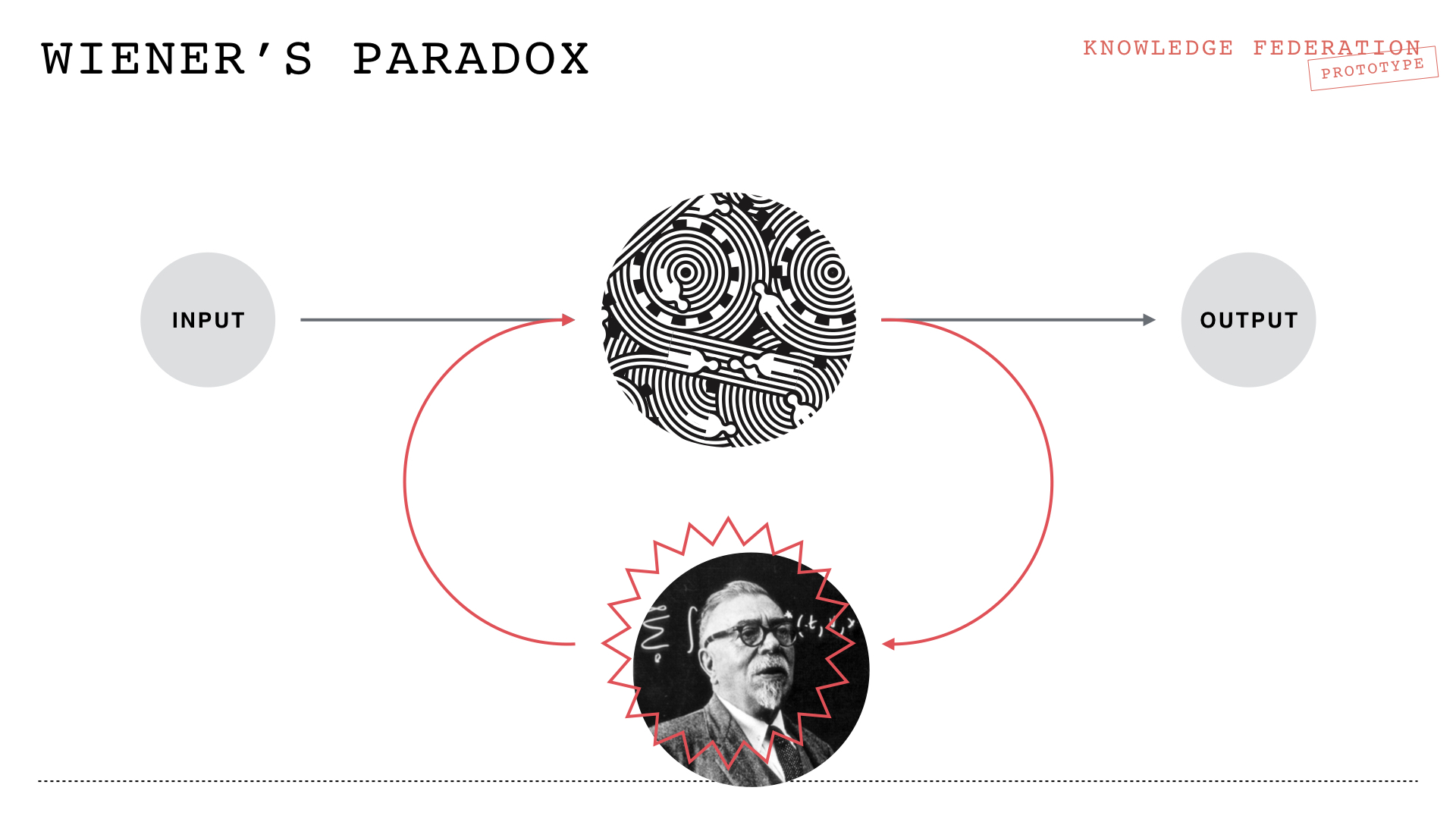Difference between revisions of "Holotopia: Collective mind"
m |
m |
||
| Line 52: | Line 52: | ||
<p>In 1968, Doug Engelbart and his SRI team provided demonstrated a <em>prototype</em> answer to Bush's call to action, which was well beyond what Bush was able to envision. The congruence between Engelbart's vision and Wiener's and Jantsch's is striking. We highlight it by showing the above four Engelbart's slides, which were intended to present his vision to the world at its 2007 presentation at Google. In Slide 3 Engelbart even used the metaphor of steering and headlights frame his call to action! The longer story will be presented in the book titled "Systemic Innovation", whose tentative subtitle is "The future of democracy". A short outline of Engelbart's story and vision is provided [http://kf.wikiwiki.ifi.uio.no/STORIES#Engelbart here]. In 2013, Engelbart passsed away decorated and celebrated, but feeling himself a failure (as we explained [https://www.dropbox.com/s/lbnq6wau5at6904/1.%20DE%20Story.m4v?dl=0 here]; his vision (whose essence we presented [https://www.dropbox.com/s/tyf1705t4hvk05s/2.%20DE%20Vision.m4v?dl=0 here]) failed to be understood, or attended to. </p> | <p>In 1968, Doug Engelbart and his SRI team provided demonstrated a <em>prototype</em> answer to Bush's call to action, which was well beyond what Bush was able to envision. The congruence between Engelbart's vision and Wiener's and Jantsch's is striking. We highlight it by showing the above four Engelbart's slides, which were intended to present his vision to the world at its 2007 presentation at Google. In Slide 3 Engelbart even used the metaphor of steering and headlights frame his call to action! The longer story will be presented in the book titled "Systemic Innovation", whose tentative subtitle is "The future of democracy". A short outline of Engelbart's story and vision is provided [http://kf.wikiwiki.ifi.uio.no/STORIES#Engelbart here]. In 2013, Engelbart passsed away decorated and celebrated, but feeling himself a failure (as we explained [https://www.dropbox.com/s/lbnq6wau5at6904/1.%20DE%20Story.m4v?dl=0 here]; his vision (whose essence we presented [https://www.dropbox.com/s/tyf1705t4hvk05s/2.%20DE%20Vision.m4v?dl=0 here]) failed to be understood, or attended to. </p> | ||
</div> </div> | </div> </div> | ||
| − | |||
| − | |||
| − | |||
| − | |||
| − | |||
| − | |||
<div class="page-header" ><h2>Ideogram</h2></div> | <div class="page-header" ><h2>Ideogram</h2></div> | ||
| Line 68: | Line 62: | ||
[[File:KFvision.jpeg]] | [[File:KFvision.jpeg]] | ||
</p> | </p> | ||
| − | <p>Our civilization is like an organism that has recently grown beyond bounds ("exponentially")—and now represents a threat to its environment, and to itself. By a most fortunate mutation, this creature has recently developed a nervous system, which could allow it to comprehend the world and coordinate its actions. But | + | <p>Our civilization is like an organism that has recently grown beyond bounds ("exponentially")—and now represents a threat to its environment, and to itself. By a most fortunate mutation, this creature has recently developed a nervous system, which could allow it to comprehend the world and coordinate its actions. But it uses it only to amplify its most primitive, limbic impulses.</p> |
</div> </div> | </div> </div> | ||
<div class="page-header" ><h2>Keywords</h2></div> | <div class="page-header" ><h2>Keywords</h2></div> | ||
| + | |||
| + | |||
| + | <div class="row"> | ||
| + | <div class="col-md-3"><h2><em>Collective mind</em></h2></div> | ||
| + | <div class="col-md-7"> | ||
| + | <p>We use this <em>keyword</em> to point to the core of Doug Engelbart's vision, as rendered in the shown four slides. When each of us is connected through an interactive interface to a digital computer, and when those computers are linked together into a network, we are in effect connected as cells in a single nervous system are. Imagine if your own cells were using your nervous system to <em>broadcast</em> messages—and you will see why broadcasting on a <em>collective mind</em> leads to collective insanity, not to "collective intelligence" (capability to cope with the complexity and urgency of our problems) as Engelbart intended.</p> | ||
| + | |||
| + | |||
| + | <div class="row"> | ||
| + | <div class="col-md-3"><h2><em>Knowledge federation</em></h2></div> | ||
| + | <div class="col-md-7"> | ||
| + | <p><em>Knowledge federation</em> can now be understood, simply, as the activity of a well-functioning or 'sane' <em>collective mind</em>. </p> | ||
| + | <p>A core task of the proposed <em>knowledge federation</em> <em>transdiscipline</em> is to draw insights from relevant fields—weave them into structural changes of academic and other institutions, to give them vision. </p> | ||
| + | </div> </div> | ||
| Line 84: | Line 92: | ||
observed David Bohm.</p> | observed David Bohm.</p> | ||
| − | <p>We use this <em>keyword</em>, the <em>Wiener's paradox</em>, to point to a sensationally alarming reality—that <em>entire academic fields</em> | + | <p>We use this <em>keyword</em>, the <em>Wiener's paradox</em>, to point to a sensationally alarming reality—that <em>entire academic fields</em> may fail to deliver to our society even the single core insights that the society needs to receive from them; the ones that would make a difference.</p> |
| − | <p>The story we told above | + | <p>And that all the publishing <em>may further obscure</em> that insight, that it may make it <em>less</em> visible and available.</p> |
| − | + | <p>The story involving Wiener, Jantsch and Reagan, which we told above, explains why.</p> | |
| − | |||
| − | |||
| − | |||
| − | |||
<p> | <p> | ||
[[File:WP.jpeg]] | [[File:WP.jpeg]] | ||
| Line 101: | Line 105: | ||
<div class="col-md-3"><h2><em>Bootstrapping</em></h2></div> | <div class="col-md-3"><h2><em>Bootstrapping</em></h2></div> | ||
<div class="col-md-7"> | <div class="col-md-7"> | ||
| − | + | <p>The key to solution is what Engelbart called <em>bootstrapping</em>—and we adopted and adapted here as a <em>keyword</em>. The point is that–in a situation where using the old system to achieve the result is useless—we must <em>create</em> new systems, with our own bodies. And/or help others do that, in a way that can scale.</p> | |
| − | <p>The key to solution is what Engelbart called <em>bootstrapping</em>—and we adopted and adapted here as a <em>keyword</em>. The point is that–in a situation where using the old system to achieve the result is useless—we must <em>create</em> new systems, with our own | + | <p>The last decades of Engelbart's career were about <em>bootstrapping</em>—see [https://youtu.be/cRdRSWDefgw this brief video excerpt]. </p> |
| − | <p>Engelbart's | + | <p>Knowledge Federation was created by an act of <em>bootstrapping</em>—to enable <em>bootstrapping</em>; see the summary [http://kf.wikiwiki.ifi.uio.no/STORIES#Engelbart here]. </p> |
| − | <p>Knowledge Federation was | ||
| − | |||
| − | |||
| − | |||
| − | |||
| − | |||
| − | |||
| − | |||
| − | |||
| − | |||
| − | |||
| − | |||
| − | |||
| − | |||
| − | |||
| − | |||
| − | |||
| − | |||
| − | |||
| − | |||
| − | |||
| − | |||
| − | |||
| − | |||
| − | |||
| − | |||
| − | |||
| − | |||
| − | |||
| − | |||
| − | |||
| − | |||
| − | |||
| − | |||
| − | |||
| − | |||
| − | |||
| − | |||
| − | |||
| − | |||
| − | |||
</div> </div> | </div> </div> | ||
| Line 153: | Line 116: | ||
<div class="row"> | <div class="row"> | ||
<div class="col-md-3"><h2>The Lighthouse</h2></div> | <div class="col-md-3"><h2>The Lighthouse</h2></div> | ||
| − | <div class="col-md-7"><p> | + | <div class="col-md-7"><p>The Lighthouse <em>prototype</em>, done in collaboration with the International Society for the Systems Sciences and for the society, was developed as a remedy for dissolving the <em>Wiener's paradox</em>. See it described [http://kf.wikiwiki.ifi.uio.no/APPLICATIONS#Lighthouse here].</p> |
</div> </div> | </div> </div> | ||
<div class="row"> | <div class="row"> | ||
<div class="col-md-3"><h2>BCN2011</h2></div> | <div class="col-md-3"><h2>BCN2011</h2></div> | ||
| − | <div class="col-md-7"><p>The Barcelona Innovation Ecosystem for Good Journalism (BCN2011) is a complete <em>prototype</em> showing how public informing can be reconstructed, to <em>federate</em> the most relevant information | + | <div class="col-md-7"><p>The Barcelona Innovation Ecosystem for Good Journalism (BCN2011) is a complete <em>prototype</em> showing how public informing can be reconstructed, to <em>federate</em> the most relevant information according to contemporary needs of people and society. A description with links is provided [http://kf.wikiwiki.ifi.uio.no/APPLICATIONS#SystemicPrototypes here].</p> |
</div> </div> | </div> </div> | ||
| Line 164: | Line 127: | ||
<div class="row"> | <div class="row"> | ||
<div class="col-md-3"><h2>TNC2015</h2></div> | <div class="col-md-3"><h2>TNC2015</h2></div> | ||
| − | <div class="col-md-7"><p>Tesla and the Nature of Creativity (TNC2015) is a complete example of <em>knowledge federation</em> in academic communication, which shows how an academic result | + | <div class="col-md-7"><p>Tesla and the Nature of Creativity (TNC2015) is a complete example of <em>knowledge federation</em> in academic communication, which shows how an academic result has been <em>federated</em>. See it described in the [https://holoscope.info/2020/01/01/tesla-and-the-nature-of-creativity Tesla and the Nature of Creativity] and [https://holoscope.info/2015/06/28/a-collective-mind-part-one/ A Collective Mind – Part One] blog posts.</p> |
</div> </div> | </div> </div> | ||
<!-- OLD | <!-- OLD | ||
| + | |||
| + | |||
| + | <b>To be continued</b> | ||
| + | |||
| + | <!-- OLD | ||
| + | |||
<div class="row"> | <div class="row"> | ||
Revision as of 13:18, 1 June 2020
Contents
- 1 H O L O T O P I A: F I V E I N S I G H T S
- 2 Collective mind
- 2.1 Stories
- 2.2 Our collective mind needs structural change
- 2.3 Democracy needs 'headlights'
- 2.4 Information technology was meant to be the remedy
- 2.5 Ideogram
- 2.6 Keywords
- 2.7 Collective mind
- 2.8 Knowledge federation
- 2.9 Wiener's paradox
- 2.10 Bootstrapping
- 2.11 Prototypes
- 2.12 The Lighthouse
- 2.13 BCN2011
- 2.14 TNC2015
H O L O T O P I A: F I V E I N S I G H T S
Collective mind
The printing press revolutionized communication, and enabled the Enlightenment. But the Internet and the interactive digital media constitute a similar revolution. Hasn't the change we are proposing, from 'the candle' to 'the lightbulb', already been completed?
We look at the way in which this new technology is being used. It has remained broadcasting—which suited the printing press. But the new technology was created to enable us to think and create together; as cells in a human mind do.
Stories
Our collective mind needs structural change
Knowledge work has a flat tire
We used the brief thread under this title, consisting of two vignettes and a punchline, as a springboard story for launching our Silicon Valley presentation of Knowledge Federation in 2011. We offer it here for the same purpose. An academic and media situation related to the climate crisis, where two esteemed scientists contradict one another on an all-important issue, is described to point to another all-important issue that is less known: 'Pressing the gas pedal and rushing ahead' (publishing and broadcasting insights of leading scientists, even in the media) is unsafe and no longer a way to reach our destination. Our situation demands that we stop and take care of a structural problem. The stories are shared here.
The largest contribution to knowledge
In this story which we used to "evangelize" the inception of Knowledge Federation as a transdiscipline, the story of growth and fragmentation of sociology is used as a parable for the situation in academia at large. Its title is an adapted Pierre Bourdieu's observation, that structural change in sociology, toward making it capable of federating knowledge, might be the largest contribution to its knowledge. It remained to point out that this Bourdieu's observation is far more true when applied to our society at large. A description with links is provided here.
Observe that an even larger contribution to knowledge is possible—which can be achieved by adding to our academic repertoire of capabilities the capability to make structural updates to knowledge-work and other institutions. Which is exactly what our proposal, to institutionalize knowledge federation transdiscipline, is about.
Democracy needs 'headlights'
Communication is the system
It seems rather obvious that the natural "systemic leverage point", or place to begin "a great cultural revival", is to provide (a way to) information that can show the way (as we submitted at the Visions of Possible Worlds conference, at the Triennale di Milano in 2003, see the transcript here.)
But that is also the key insight Wiener was intended to communicate in the mentioned last chapter of his 1948 Cybernetics (a copy of which we provided here). The most elementary fact reaching us from cybernetics is that a system needs "communication (or feedback) and control" ('headlights' and 'steering') to be governable or viable. Communication, Wiener observed, is the system (being what enables a collection of disparate entities to function together as an entity).
We need "evolutionary guidance"
We have introduced Erich Jantsch as a link between the universe of the systems sciences, and the universe where The Club of Rome belongs, where the goal is to secure our civilization's future. Erich Jantsch's final message, however, may be summarized by the formula that intervening into (or "designing for") the evolution is the key to our contemporary situation (see our summaries here and here). Which is, once again, what the bus with candle headlights is pointing to (the 'way' that the 'bus' is following is our society's evolution).
"The invisible hand" won the argument
Coincidentally, Erich Jantsch passed away in the same year when Ronald Reagan became the US president—on an agenda opposite to his and wiener's.
Reagan did not win by the force of the argument, but by having incomparably more "air time" than our two academic heroes.
We may now see who 'keeps Galilei in house arrest', and how. Well before the advent of the Internet, Umberto Eco compared the New York Times and (then the main Soviet communist paper) Pravda in an interview, to argue that while in the latter censorship was achieved directly, in the former overabundance of information had the same effect.
Information technology was meant to be the remedy
Vannevar Bush's call to action
Wiener developed his argument in the last chapter of Cybernetics partly by quoting Vannevar Bush—at the time the academic strategist par excellence, who already in 1945 pointed to the issue at hand as the one to which the scientists must give the highest priority, (see our summary here).
Doug Engelbart's response
In 1968, Doug Engelbart and his SRI team provided demonstrated a prototype answer to Bush's call to action, which was well beyond what Bush was able to envision. The congruence between Engelbart's vision and Wiener's and Jantsch's is striking. We highlight it by showing the above four Engelbart's slides, which were intended to present his vision to the world at its 2007 presentation at Google. In Slide 3 Engelbart even used the metaphor of steering and headlights frame his call to action! The longer story will be presented in the book titled "Systemic Innovation", whose tentative subtitle is "The future of democracy". A short outline of Engelbart's story and vision is provided here. In 2013, Engelbart passsed away decorated and celebrated, but feeling himself a failure (as we explained here; his vision (whose essence we presented here) failed to be understood, or attended to.
Ideogram
Our civilization is like an organism that has recently grown beyond bounds ("exponentially")—and now represents a threat to its environment, and to itself. By a most fortunate mutation, this creature has recently developed a nervous system, which could allow it to comprehend the world and coordinate its actions. But it uses it only to amplify its most primitive, limbic impulses.
Keywords
Collective mind
We use this keyword to point to the core of Doug Engelbart's vision, as rendered in the shown four slides. When each of us is connected through an interactive interface to a digital computer, and when those computers are linked together into a network, we are in effect connected as cells in a single nervous system are. Imagine if your own cells were using your nervous system to broadcast messages—and you will see why broadcasting on a collective mind leads to collective insanity, not to "collective intelligence" (capability to cope with the complexity and urgency of our problems) as Engelbart intended.
Knowledge federation
Knowledge federation can now be understood, simply, as the activity of a well-functioning or 'sane' collective mind.
A core task of the proposed knowledge federation transdiscipline is to draw insights from relevant fields—weave them into structural changes of academic and other institutions, to give them vision.
Wiener's paradox
observed David Bohm.As long as a paradox is treated as a problem, it can never be dissolved,
We use this keyword, the Wiener's paradox, to point to a sensationally alarming reality—that entire academic fields may fail to deliver to our society even the single core insights that the society needs to receive from them; the ones that would make a difference.
And that all the publishing may further obscure that insight, that it may make it less visible and available.
The story involving Wiener, Jantsch and Reagan, which we told above, explains why.
By committing his own results to the "feedback loop" that—as he himself diagnosed—was broken, Norbert Wiener fell prey to a paradox.
How can this predicament be avoided?
Bootstrapping
The key to solution is what Engelbart called bootstrapping—and we adopted and adapted here as a keyword. The point is that–in a situation where using the old system to achieve the result is useless—we must create new systems, with our own bodies. And/or help others do that, in a way that can scale.
The last decades of Engelbart's career were about bootstrapping—see this brief video excerpt.
Knowledge Federation was created by an act of bootstrapping—to enable bootstrapping; see the summary here.
Prototypes
The Lighthouse
The Lighthouse prototype, done in collaboration with the International Society for the Systems Sciences and for the society, was developed as a remedy for dissolving the Wiener's paradox. See it described here.
BCN2011
The Barcelona Innovation Ecosystem for Good Journalism (BCN2011) is a complete prototype showing how public informing can be reconstructed, to federate the most relevant information according to contemporary needs of people and society. A description with links is provided here.
TNC2015
Tesla and the Nature of Creativity (TNC2015) is a complete example of knowledge federation in academic communication, which shows how an academic result has been federated. See it described in the Tesla and the Nature of Creativity and A Collective Mind – Part One blog posts.




